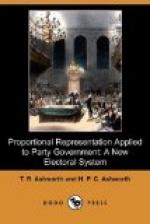We have dwelt at some length on the preceding example, because it serves to refute another error into which some of the proportionalists have fallen. It is held that the unit of representation should be ascertained by dividing the total votes, not by the number of seats, but by the seats increased by one. This unit is generally known as the Droop quota, having been proposed in a work published by Mr. H.R. Droop in 1869. Since one vote more than one-half of the total votes is sufficient for election in a single-seat electorate, it is argued that one vote more than one-third suffices in a two-seat electorate, one vote more than one-fourth in a three-seat electorate, and so on. The unit in a six-seat electorate would be one-seventh of the votes instead of one-sixth, and it is pointed out that by this means the whole six seats would be filled by whole units, leaving an unrepresented residuum of one-seventh of the votes divided between the two parties.
The error lies precisely as before in concentrating attention on one of the electorates, and in neglecting the theory of probability. The Droop quota introduces the condition that each party must pay a certain minimum number of votes for each seat, and the real distinction is that, instead of the minority and the majority having an equal chance of securing any advantage, the chances are in the same proportion as their relative strengths. If the majority be twice as strong as the minority, it will have twice the chance of gaining the advantage. To prove this, consider the position of a one-third minority in a number of five-seat electorates. The Droop quota being one-sixth of the votes, the minority will secure two seats or 40 per cent. in those electorates where it is just over one-third, and one seat or 20 per cent. where it is just under. Since the mathematical chances are that it will be over in one half and under in the other half, it will, on the average, secure only 30 per cent., although entitled to 33 per cent. Again, if the 670 members of the House of Commons were elected in three to five-seat electorates, and the Droop quota used as proposed by Sir John Lubbock, and if the Ministerialists were twice as strong as the Oppositionists, they would, on the average, return 30 more members than the two-thirds to which they are entitled, and this would count 60 members on a division.
The following table illustrates the erroneous result obtained by applying the Droop quota when a number of grouped-electorates are concerned. It will be noticed that where parties are nearly equal it makes very little difference which unit is used:—
+-------------+----------------------------------------
----+ | STRENGTH OF | AVERAGE REPRESENTATION. | | +----------------------+---------------------+ | PARTY |Five-Seat Electorates.|Ten-Seat Electorates.| +-------------+----------------------+---------------------+
| 10 per cent.| 2 per cent. | 6 per cent. | | 20 " " | 14 " " | 17 " " | | 30 " " | 26 " " | 28 " " | | 40 " " | 38 " " | 39 " " | | 50 " " | 50 " " | 50 " " | +-------------+----------------------+---------------------+
The Droop quota, therefore, gives, not proportional, but disproportional representation.




